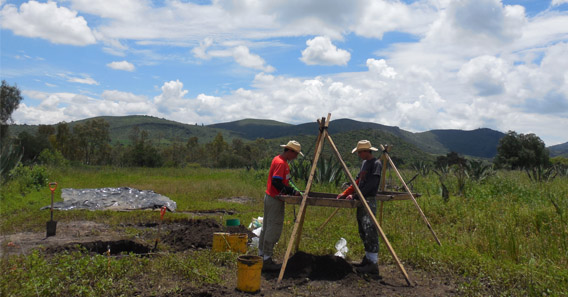
Alexander Jurado ’15 Interned in San Juan Teotihuacan, Mexico
It is my first day in the field and I am feeling a mix of fatigue, excitement and nerves. Fatigue because a fever knocked me out of commission to miss the first three days of the season. Excitement because working on an archaeological excavation has always been a dream of mine. And nerves because I am about to enter a field of cactuses, brush and waste high grass, the prime environment for rattlesnakes. “Be careful and watch where you step, I’ve heard there is a rattlesnake nest around here,” says one of the locals. The archaeologists charge fearlessly into the field; the locals pick their way more cautiously through the grass; I pause to tell myself, This is what you always wanted, and if you want to be an archaeologist you better get used to it. I plunge into the grass. After about an hour of making artifact surface collections with no snake encounters, I am finally starting to relax; one might even say I am starting to feel right at home. Maximiliano is walking alongside me and we are talking as we go. Suddenly he yells, “SNAKE!” almost falling on his back as he stumbles backwards. I freeze immediately, not daring to move even an inch forward. He is pointing saying, “Right there,” but I still can’t see it anywhere. Finally I pick out the rattlesnake coiled on the ground just three feet in front of us. The grey scales and black diamond pattern allow it to blend in perfectly. At this point it’s my first day and I almost stepped on a rattlesnake–and I still got six more weeks to go.
This summer I had the incredible opportunity to work on an archaeological investigation near San Juan Teotihuacan, Mexico at a site called Altica. Altica is a small settlement dating to the Formative-period (1800BC-100AD), making it one of the earliest sites in the Basin of Mexico. Altica’s early inhabitants dedicated themselves to obsidian tool production. I spent five days a week working in the field at the excavation site. My responsibilities included excavating, writing field notes, sifting dirt for artifacts, creating sketches and drawings, taking depth measurements, tagging and bagging artifacts, and back-filling excavated units. Saturdays were spent working in the laboratory where I washed and counted artifacts, and wrote summaries of the excavations that I had overseen. Working on the Altica Project was the perfect summer experience for me as an Anthropology major, and also for my Archaeology career path. I gained valuable field experience that not only trained me for future projects, but also made me a much more competitive graduate school applicant. Working alongside students and archaeologists from different universities and countries, as well as the local farmers, was one of the most enjoyable aspects of the summer. It was an unforgettable authentic cultural experience.
At the beginning of the summer I was quite nervous about joining this archaeological investigation given my lack of experience and having never worked on an archaeological excavation before. However, from day one I did the only thing I could do; learn on the go and work my hardest at all times. I felt like I rose to the occasion, and at the end of the summer my supervisor told me that I had done a fantastic job. It really taught me how I can learn fast and excel in a position despite lacking prior experience and training. It was an important confidence boost in my own capabilities, especially as I begin to consider and look for jobs ahead.
The most important professional take away from this archaeological excavation was the affirmation that this is what I want to spend my life doing. I felt so at home excavating in the fields that nothing would make me happier than a career in archaeology. Talking with archaeologists and graduate students this summer also gave me a better idea of what will be required of me in the years ahead as I pursue a PhD. I need to start thinking now about whom I would like to work with and what research questions I would like to answer. This summer made me realize that not only is a career in archaeology what I want, but also how difficult the process is. The reality is that there are very few teaching positions available at universities for archaeologists, and so obtaining that job is never a guarantee. In fact, most archaeologists do not teach, but rather conduct consultant archaeology. This has not averted me from my intended career path, but rather opened my eyes to an important alternative to being a college professor. I still want to be a college professor, but I now have a better understanding of what I am getting into. I am now more prepared than ever to work hard for what I want.

